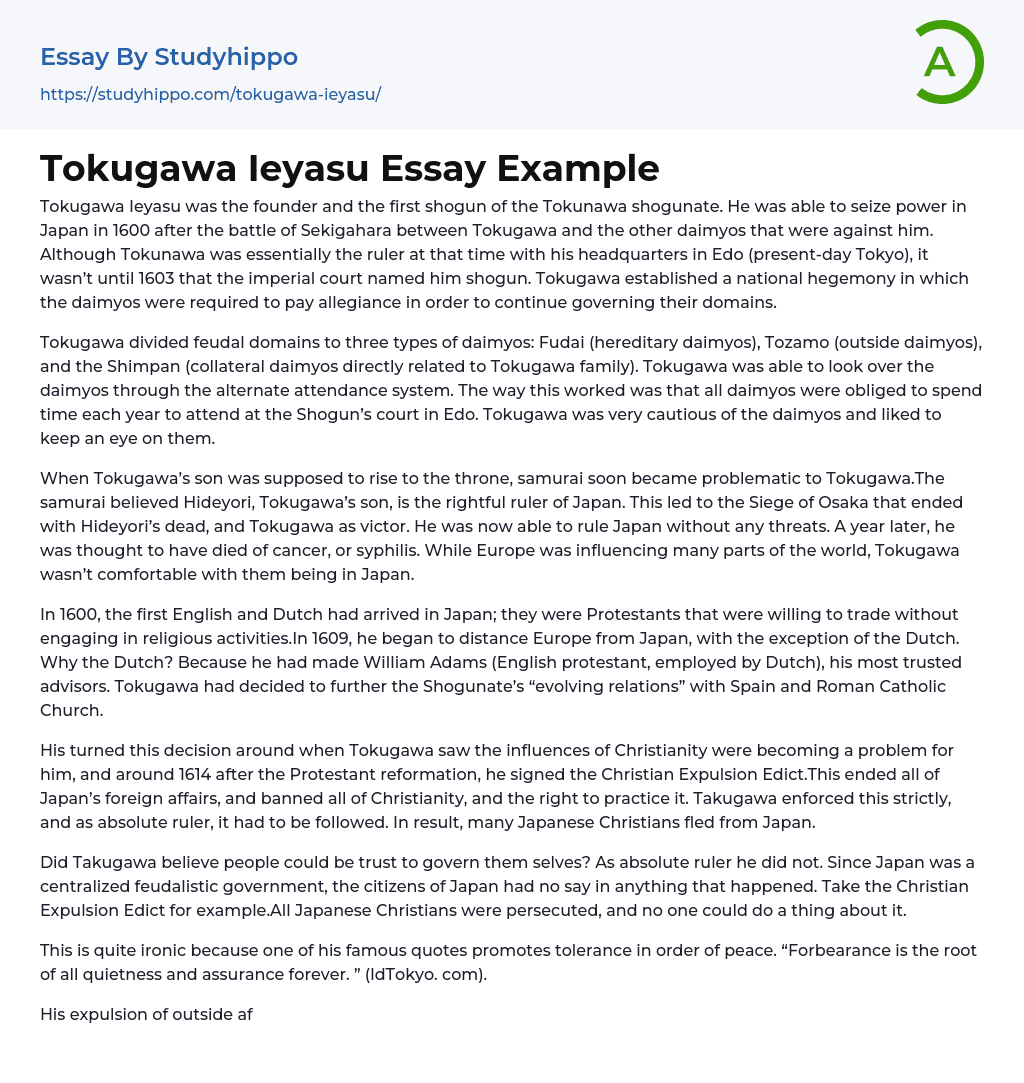Tokugawa Ieyasu was the founder and the first shogun of the Tokunawa shogunate. He was able to seize power in Japan in 1600 after the battle of Sekigahara between Tokugawa and the other daimyos that were against him. Although Tokunawa was essentially the ruler at that time with his headquarters in Edo (present-day Tokyo), it wasn’t until 1603 that the imperial court named him shogun. Tokugawa established a national hegemony in which the daimyos were required to pay allegiance in order to continue governing their domains.
Tokugawa divided feudal domains to three types of daimyos: Fudai (hereditary daimyos), Tozamo (outside daimyos), and the Shimpan (collateral daimyos directly related to Tokugawa family). Tokugawa was able to look over the daimyos through the alternate attendance system. The way this worked was that all daimyos were
...obliged to spend time each year to attend at the Shogun’s court in Edo. Tokugawa was very cautious of the daimyos and liked to keep an eye on them.
When Tokugawa’s son was supposed to rise to the throne, samurai soon became problematic to Tokugawa.The samurai believed Hideyori, Tokugawa’s son, is the rightful ruler of Japan. This led to the Siege of Osaka that ended with Hideyori’s dead, and Tokugawa as victor. He was now able to rule Japan without any threats. A year later, he was thought to have died of cancer, or syphilis. While Europe was influencing many parts of the world, Tokugawa wasn’t comfortable with them being in Japan.
In 1600, the first English and Dutch had arrived in Japan; they were Protestants that were willing to trade without engaging in religious activities.In 1609, he began to distance Europe fro
Japan, with the exception of the Dutch. Why the Dutch? Because he had made William Adams (English protestant, employed by Dutch), his most trusted advisors. Tokugawa had decided to further the Shogunate’s “evolving relations” with Spain and Roman Catholic Church.
His turned this decision around when Tokugawa saw the influences of Christianity were becoming a problem for him, and around 1614 after the Protestant reformation, he signed the Christian Expulsion Edict.This ended all of Japan’s foreign affairs, and banned all of Christianity, and the right to practice it. Takugawa enforced this strictly, and as absolute ruler, it had to be followed. In result, many Japanese Christians fled from Japan.
Did Takugawa believe people could be trust to govern them selves? As absolute ruler he did not. Since Japan was a centralized feudalistic government, the citizens of Japan had no say in anything that happened. Take the Christian Expulsion Edict for example.All Japanese Christians were persecuted, and no one could do a thing about it.
This is quite ironic because one of his famous quotes promotes tolerance in order of peace. “Forbearance is the root of all quietness and assurance forever. ” (ldTokyo. com).
His expulsion of outside affairs also shines a light on Tokugawa’s view on the spread of ideas in Japan. As long as it does not show to be a problem to how Takugawa rules Japan, then it is ok.
- Puritans essays
- Afterlife essays
- Buddhism essays
- Christianity essays
- Deism essays
- Faith essays
- God essays
- Hinduism essays
- Islam essays
- Jews essays
- Judaism essays
- Monotheism essays
- New Testament essays
- Ritual essays
- Sin essays
- Soul essays
- Theology essays
- Confession essays
- Devil essays
- Miracle essays
- Monk essays
- Revelation essays
- Atheism essays
- Immortality essays
- Jainism essays
- Sinners essays
- Bible essays
- Old Testament essays
- Salvation essays
- Temple essays
- Taoism essays
- Pilgrimage essays
- Freedom Of Religion essays
- Existence of God essays
- Christian Worldview essays
- Cosmological Argument essays
- Gautama Buddha essays
- Karma essays
- Buddha essays
- Baptism essays
- Holy Spirit essays
- Jesus Christ essays
- Adam And Eve essays
- Crucifixion Of Jesus essays
- Crusades essays
- Eucharist essays
- God The Father essays
- Pope essays
- Protestantism essays
- Christian essays




